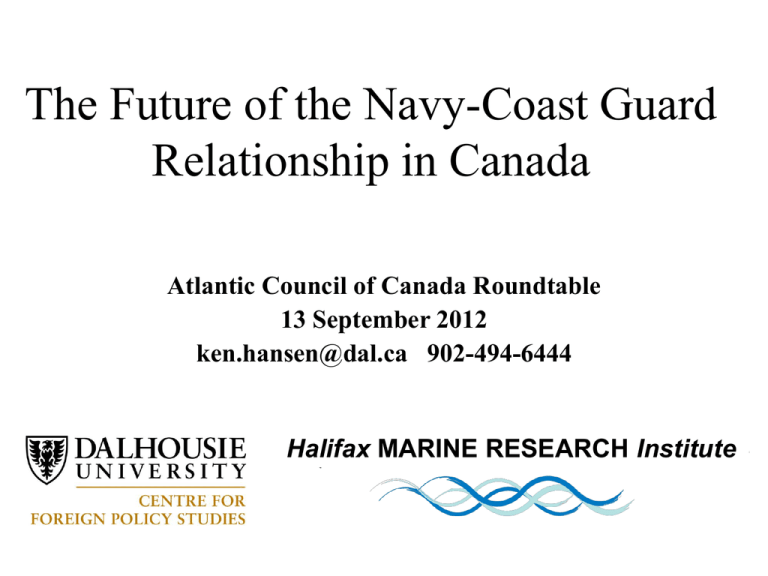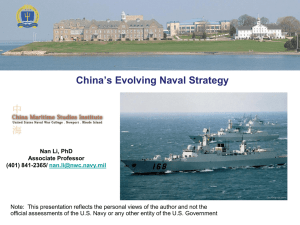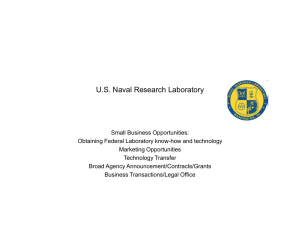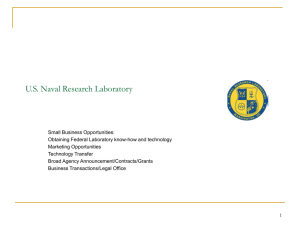The Future of the Navy-Coast Guard Relationship in Canada
advertisement

The Future of the Navy-Coast Guard Relationship in Canada Atlantic Council of Canada Roundtable 13 September 2012 ken.hansen@dal.ca 902-494-6444 Halifax MARINE RESEARCH Institute Aim • To conduct a ‘blue sky’ vision session • To discuss five questions in open forum CFPS Research Project CFPS Research Workshop “Western Hemisphere Perspectives and Approaches to Future Maritime Security Challenges” Published: 22 June 2010 Conducted: 27-29 October 2011 Five Questions 1. How does the Canadian Navy-Coast Guard Relationship compare internationally? 2. Should the Canadian Coast Guard be armed? 3. What should the role of the Canadian Coast Guard be in time of conflict or war? 4. Should the Royal Canadian Navy do more or less in support of Canadian law enforcement? 5. How will the relationship between the RCN and CCG evolve in arctic patrolling operations? Outline • • • • • • The geographic context The CCG-Navy by the Numbers (Q1) A Typology Analysis of Ships (Q2) The Relationship in Conflict and War (Q3) The Roles of the Sea Services (Q4) Navy-Coast Guard in the Arctic (Q5) Present Size of Canada’s Offshore Rank Country Size of EEZ 1 USA 11,351,000 km² 7 Indonesia 6,100,000 km² 8 Canada 5,599,077 km² 9 Japan 4,500,000 km² Future Size of Canada’s Offshore Rank Country Size of EEZ 1 USA 11,351,000 km² 4 Russia 7,500,000 km² 5 Canada 7,499,151 km² 6 U.K. 6,800,000 km² +33.9% CFPS Research Project Coast Guard-Navy Functions and Organizational Overlaps 150 states have coastlines – 72 have coast guards Home Civil Reactive Para-Military Away Military Proactive Source: J Matthew Gillis, The Global Navy/Coast Guard Relationship, CFPS, 2010 Navy Only 28 Coast Guard & Navy 63 USCG Military Coast Guard & Navy 9 USN Para Military Coast Guard & Navy 53 CCG Coast Guard 2 Civil RCMP ? Coast Guard Only 9 Navy 2 RCN CFPS Research Workshop Strategy Begins with Awareness – Similarities & Differences Language Free Societies Allied Economies Democracies Borders Arts Sports Families Republic Currency History Policies Strategy Driven 9/11 United States Landmass = 1: 1.01 Coastline = 1: 10.29 Monarchy Currency History Policies Management Driven Canada Pop., Economy, Capacity = 10: 1 Context, Context, Context is Key Source: Hansen – Rutgers University, “Institutional Misalignment,” 8 November 2011 ‘Average’ Coast Guard(s) by Pop. Avg. civilian model is 27.2% of the manpower strength of the regular force naval strength = 2,998 people; Average paramilitary model is 20.9% of naval strength = 2,304 people; or Average military model runs is 12.2% of naval strength = 1,345 people. In Canada, the CCG is 84.2% of naval strength = 9,350 people. Source: J Matthew Gillis, The Global Navy/Coast Guard Relationship, CFPS, 2010 Question #1 How does the Canadian Navy-Coast Guard Relationship compare internationally? Typology of Vessels Civil Military Source: NATO Standardization Agreement 1166MT “Standard Ship Designator System,” 2 Oct. 2000 Combatants • Naval, Coastguard and Government-owned vessels/craft which possess some sort of inherent armed or combat capability primarily intended for offensive use. The general rationale behind the groupings for combatant vessels is as follows: • SS - Submarines • DD - Principle Surface Combatants • PB - [Coastal] Patrol Vessels • PC - River/Roadstead Patrol Vessels • MM - Mine Warfare Vessels • LL - Amphibious Warfare Vessels • WW - Coastguard: All vessels or craft owned or operated by a Coastguard service V – Police vessel or craft Z – Government vessel or craft Source: NATO Standardization Agreement 1166MT “Standard Ship Designator System,” 2 Oct. 2000 Non-Combatants • Auxiliary, Service Support or Merchant/Recreational Vessel types, which tend to be role specific. They may possess an armed or combat capability intended primarily for self defence purposes. The general groupings follow: • AA - Auxiliary Vessels (General) • YY - Service Craft • VJ – Police Hovercraft • ZS – Government Submersibles • TM – Merchant (General) • TU – Fishing (General) • YAC – Pleasure Craft (Yacht) Source: NATO Standardization Agreement 1166MT “Standard Ship Designator System,” 2 Oct. 2000 Typology of Vessels (I) Military Civil Non-Combatants Combatants 7 types 5 types YAC TM/U VJ/ZS YY ? AA WDD Coast Guard Armed - Defensive MM PC PB DD SS Navy Naval ? ? LL Coast Guard Armed - Offensive Source: NATO Standardization Agreement 1166MT “Standard Ship Designator System,” 2 Oct. 2000 Non-Combatants • Auxiliary, Service Support or Merchant/Recreational Vessel types, which tend to be role specific. They may possess an armed or combat capability intended primarily for self defence purposes. The general groupings follow: • AA - Auxiliary Vessels (General) Service and Support • YY - Service Craft Government Owned • VJ – Police Hovercraft • ZS – Government Submersibles Merchant • TM – Merchant (General) • TU – Fishing (General) Recreational • YAC – Pleasure Craft (Yacht) Source: NATO Standardization Agreement 1166MT “Standard Ship Designator System,” 2 Oct. 2000 Typology of Vessels (II) Military Civil Non-Combatants Combatants 7 types 5 types Civil YAC TM/U Unarmed Government-owned Service Support Auxiliary VJ/ZS YY AA Armed - Defensive WDD Coast Guard LL MM PC PB DD SS Navy Armed - Offensive Source: NATO Standardization Agreement 1166MT “Standard Ship Designator System,” 2 Oct. 2000 [Canadian] Typology of Vessels Military Civil Non-Combatants Combatants 5 types 6 types Civil YAC Government-owned Service Support Auxiliary TM/U WPGB VJ/ZS YY AOR Naval LL MM PC PB DD ‘Sustain’ AD/AS/AR ‘Support’ AE/AF/AO ‘Supply’ Unarmed Armed - Defensive Armed - Offensive Source: Hansen, “Canadian Naval Operational Logistics: Lessons Learned, Lost, and Relearned?” The Northern Mariner, Vol. XX, No. 4 (October 2010): 361-383. SS Hybridized Vessels Problems Military Civil Non-Combatants Combatants 5 types 6 types Civil YAC Government-owned Service Support Auxiliary TM/U WPGB Cdn Coast Guard T-AGB US Military Sealift T-AKE T-AFS Unarmed VJ/ZS YY AOR Naval LL MM PC PB DD SS ‘Sustain’ AOPS? Armed - Defensive JSS? Armed - Offensive Source: NATO Standardization Agreement 1166MT “Standard Ship Designator System,” 2 Oct. 2000 Cross-Border Crime • Two-way problem • Criminal organizations seek vulnerabilities in geography and enforcement • Organized crime is the most prevalent threat encountered • Over 100 crime groups and 90 criminal entrepreneurs involved in cross-border crime Link: http://www.rcmp-grc.gc.ca/ibet-eipf/reportsrapports/2010-threat-menace-eng.htm “Crime moves swiftly to exploit ‘gap’ areas” Source: CSupt. Joe Oliver, RCMP, Maritime Security Workshop, 29 October 2011 Institutional National A National Alignment Plan? Culture Gov’t Cmtte Dept Dept Panel Tactical Manager ? Conflict Coexist Coordinate ? Cooperate ? Collaborate Degree of Alignment Conglomerate Source: Hansen – CJSOE Security Conf., “Institutional Change,” 4 June 2012 Question #2 Should the Canadian Coast Guard be armed? National Shipbuilding Strategy 28 Large Vessels • Combat Ships: –Arctic & Offshore Patrol Ships (6+2) –Canadian Surface Combatants (15) • Non-Combat Ships: –CCG Science Vessels (4) –DND Joint Support Ships (2+1) –CCG Polar Icebreaker (1) Source: NSPS Media Tech Briefing, 18 Oct 2011 The Peace-Conflict Continuum Source: WT. Johnsen, Redefining Land Power for the 21st Century, US Army War College, Strategic Studies Institute, 1998 Coast Guard in Conflict or War? Far from emphasizing the extreme case of amphibious assault against defended beachheads, traditional naval support roles in expeditionary warfare most commonly involve cover, administrative support, and supply operations. These are not departures from history. Rather, they are the usual, but nonetheless essential, roles of naval forces in expeditionary warfare. Source: Milan Vego, Naval Strategy and Operations in Narrow Seas (London: Frank Cass, 2003), 269. Questions #3 What should the role of the Canadian Coast Guard be in time of conflict or war? The Three Functional Roles of ‘Maritime Security Forces’ Use of the Sea Military Role Ken Booth’s Triangle - Navies and Foreign Policies, 1977, 15-16. Adapted from: Securing Canada’s Ocean Frontier, 2005, 18. A “Tri-Modal” Force Structure • Military Role (How will Canada fight?) - High-end combat capabilities - Sustainment of Operations • Constabulary Role (When to use naval force?) - Low-end combat capabilities - Support to OGDs • Diplomatic Role (What do Canadians expect?) - Support to Humanitarian Support & Disaster Relief - Supply to Capacity Building and Assistance Efforts Adapted from: Hughes, “A Bi-Modal Force Structure for National Maritime Strategy,” Naval War College Review, Spring 2007, 29-47. The Three Roles of ‘Maritime Security Forces’ Use of the Sea Military Role In the presence of a recognized military threat. Ken Booth’s Triangle - Navies and Foreign Policies, 1977, 15-16. Source: Hansen, POLI 3591, Issues in Contemporary Maritime Security, Lecture 8. Where is the Navy Going? Future Surface Combatants? Image:http://www.globalsecurity.org/military/world/europe/images/future_surface_combatant3.jpg Ken Booth’s Triangle - Navies and Foreign Policies, 1977, 15-16. Use of the Sea Constabulary Role When criminal activity impedes or restricts legitimate activity. The Three Roles of ‘Maritime Security Forces’ Source: Hansen, POLI 3591, Issues in Contemporary Maritime Security, Lecture 8. Where is the navy going? Naval Arctic & Offshore Patrol Ship? Source: http://www.forces.gc.ca/admmat-smamat/documents/Big%20AOPS%20pics/AOaftstbd2.jpg Where is the coast guard going? Mid-shore Patrol Cutters? Specifications for the new Mid-Shore Patrol Vessel / Damen Stan Patrol 4207: Length overall: 42.80 m Speed range: 23.0 - 30.0 knots (42.6 - 55.5 km/h) Ship's Boat: RHIB (rigid hull inflatable boat) Source: http://www.casr.ca/doc-news-mid-shore-patrol-vessel-2009.htm Image: http://www.damen.nl/PRODUCTS/Damen_Stan_Patrol_4207.aspx?mId=8643&rId=150&Big=1 Ken Booth’s Triangle - Navies and Foreign Policies, 1977, 15-16. Use of the Sea Diplomatic Role When foreign policy goals/national interest are at stake. The Three Roles of ‘Maritime Security Forces’ Source: Hansen, POLI 3591, Issues in Contemporary Maritime Security, Lecture 8. Where is the navy going? JSS or Oiler-Replenisher? Left - Berlin-class (Germany) Right - Mistral-class amphibious assault, command and force projection ship (France) Images: German and French navies. Ken Booth’s Triangle – Adapted for the ‘New Security Environment’. Reputation Response Compassion Respect Military Role Peace The Three Roles of ‘Maritime Security Forces’ Source: Hansen, POLI 3591, Issues in Contemporary Maritime Security, Lecture 8. Questions #4 Should the Royal Canadian Navy do more or less in support of Canadian law enforcement? Canada’s 18 Icebreakers Type Number Notes Built Not same class 1968, ‘83 Medium 4 (–1) Amundsen: scientific 1979-‘87 Light High Endurance & Multi-purpose Medium Endurance & Multi-purpose Air Cushion Vehicles 1970, 1986-‘87 1968, 1985-‘86 Heavy 2 Arctic/Gulf Icebreakers 7 (1+6) River Icebreakers Light 3 (1+2) Light 2 2009 Source: Hansen – Sino-Canadian Conf., “Practical Arctic Security,” 26 June 2012 CCGS Louis St. Laurent ‘Heavy’ [Arctic] Icebreaker Image: shipspotting.net CCGS Amundsen T1200-class ‘Medium’ [Gulf] Icebreaker Image: Marc Tawil Arctic Net CCGS Sir William Alexander T1100-class ‘Light’ [River] Icebreaker Image: shipspotter.com AOPS Deficiencies? • “Endurance: 6,800 nm at 14 knots transit speed – 6,800 nm ‘not enough’ according to CCG; – Should be able to increase range with speed of 10 knots (+/-10,000 nm).” • AOPS is “slow and dumb” according to Senator Colin Kenny; it is a “slushbreaker.” Source: AOPS Briefing, Project Manager, Dalhousie University, 5 Oct 2011. Where Does AOPS ‘fit’ as an Icebreaker? Class Displace’t Length Beam Draught Engines Motors Speed Range Endurance Bunkers St. Laurent 11,345 t. 119.6 m. 24.4 m. 9.9 m. 29,400 kw 20,142 kw 20 kts 23,000 nm 205 days 3,500 m³ T1200 6,097 98.2 19.8 7.4 17,700 12,174 16.5 15,000 192 2,200 T1100 3,809 83.0 16.2 5.8 8,847 5,250 16.5 6,500 120 785 AOPS 5,730 97.5 19.0 5.7 13,200 9,000 17 6,800 120 690 25 CCG Class Comparisons (I) 20 15 St Laurent 10 T1200 5 T1100 .5 1.0 KNM 1.5 2.0 Range 2.5 3.0 3.5 25 CCG Class Comparisons (II) St Laurent 20 15 T1200 10 T1100 5 .5 1.0 1.5 2.0 2.5 Bunkers 3.0 Km³ 3.5 AOPS Class Analysis 25 St Laurent 20 15 T1200 St Laurent 10 AOPS 5 T1100 AOPS T1200 T1100 .5 1.0 KNM 1.5 2.0 Range 2.5 Bunkers 3.0 Km³ 3.5 AOPS V1 versus V2 Class Displace’t Length Beam Draught Engines Motors Speed Range Endurance Bunkers T1200 6,097 t 98.2 m 19.8 m 7.4 m 17,700 kw 12,174 kw 16.5 kts 15,000 nm 192 days 2,200 m³ AOPS V1 6,940 109.6 18.2 7.0 18,000 15,000 20 8000 e 120 810 e Note: e = estimated using change in displacement. AOPS V2 5,730 97.5 19.0 5.7 13,200 9,000 17 6,800 120 690 Change -17.4% -11.0% +4.4% -18.6% -27% -40% -15% -17.4 e NC -17.4 e AOPS Class Analysis (II) 25 St Laurent 20 AOPS1 15 T1200 St Laurent 10 AOPS2 5 T1100 AOPS2 AOPS1 T1200 T1100 .5 1.0 KNM 1.5 2.0 Range 2.5 Bunkers 3.0 Km³ 3.5 Naval Bias Against Fuel Capacity Class St. Laurent Displacem’t 11,345 t Bunkers* 3500 m³ Ratio (D) .31 m³/t T1200 T1100 AOPS V2 6,097 3,809 5,730 2,200 785 690 .36 .21 V2 = .120 V1 = .117 Halifax-class frigates: ratio = .10 per tonne of displacement Note*: Assumes 10% of total fuel capacity unusable/not loaded. CCGS Radisson refuelling HMCS Toronto, Operation Nanook, 2008 Image: Canadian Naval Review, Vol. 7, No.4 (Winter 2012): 18. CCG Fuel Consumption Class St. Laurent T1200 T1100 Endurance Bunkers ‘Min.’ Rate* ‘Normal’ Rate ‘High’ Rate 205 days 3500 m³ 15.4 m³/day 30 m³/day e 75 m³/day e 192 2,200 10.3 20.0 50.0 120 785 5.9 10 e 25 e [+/-1000 m³/day] Note*: Assumes 10% of total fuel capacity unusable/not loaded. Source: Mr. N. Hawksworth – C. Eng. CCG, Atlantic Region RCN Sustainment of CCG Operations Class T1200 Gain T1100 Gain Bunkers Min. Rate ‘Normal’ Rate ‘High’ Rate 2,200 m³ 10.3 m³/day 20.0 m³/day 50.0 m³/day 9.1% 19.4 days 10 days 4 days 785 5.9 11.8 e 29.5 e 25.5 33.9 16.9 6.8 Note: e = estimated equating rate increase from T1200 class. Assumes approximately 200 cubic metres of fuel (one-third of AOPS’s useable fuel capacity of 620 cubic metres) is available for transfer to CCG ship. Estimated gain for St. Laurent is 5.7% of total bunker capacity, and 13 days (min., 15.4 cum/day), 6.5 days (normal, 30.8 cum/day) or 2.6 days (high, 77 cum/day) of operation (using same equating rate from T1200 class). A RCN Sustainment ‘Train’ (I) • Assuming 10-knot transit speed and 6 hours for reloading, 1XAOPS could deliver 200 tonnes of fuel at a distance of: - 3,800 nm to a T1100 CCG icebreaker operating a ‘low’ rate; - 1,170 nm to a T1200 CCG icebreaker operating at a ‘normal’ rate; or - 280 nm to CCG Louis St. Laurent operating at a ‘high’ rate of fuel consumption. • Adding a second AOPS doubles the rate of delivery or the range at which they can sustain a CCG ship. RCN Sustainment ‘Train’ (II) • A ‘cold weather capable’ RCN sustainment ship (AOR), could deliver approximately 7,000 m³ of fuel to the ice-edge or a suitable anchorage near the ice-edge. • The AOR could: - act as a ‘station tanker’; - replenish shore or barge tanks; or - employ AOPSs (or CCG ships) as ‘shuttles’. Comment from CCG Chief Engineer, CCGS Louis St. Laurent: “This could change everything.” Image: BMT Aegir 18R-class commercial AOR Question #5 How will the relationship between the RCN and the CCG evolve in arctic patrolling operations? Read More Here • Canadian Naval Review at: http://www.navalreview.ca/ • The Global Navy/Coast Guard Relationship: A Mandate-Based Typology, J. Matthew Gillis, CFPS 2010 at: http://centreforforeignpolicystudies.dal.ca/pdf/GillisOutputsAndProducts.pdf • “Broadsides,” the on-line discussion forum of Canadian Naval Review, at: http://www.navalreview.ca/broadsides-discussionforum/







